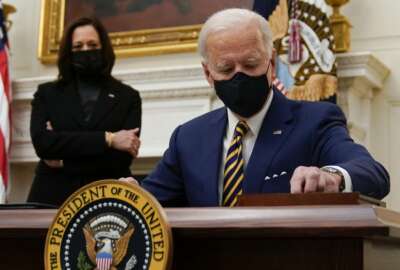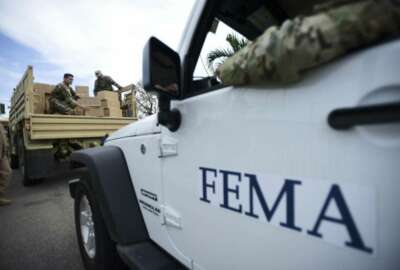

COVID-19 highlighted weaknesses in the federal emergency response chain of command and medical supply lines. But the agency's acting chief told senators FEMA has a...
Right now, FEMA is dealing with 960 declared disasters around the country – at least one in every state – and not all of them are COVID-19 related. Of the agency’s 52 federal coordinating officers for disaster management, only one is not currently assigned to a disaster.
Aside from the pandemic – FEMA is helping with an influx of migrants at the southern border, prepping for wildfire and hurricane seasons, and responding to damage from severe winter storms across the middle of the country. However, it was COVID-19 specifically that highlighted weaknesses in the chain of command. A report released in January said that neither FEMA nor the Department of Health and Human Services understood the domestic supply chain at the beginning of this response.
“When COVID-19 was declared an emergency back in March of last year, FEMA was directed to lead a whole of government federal response to the pandemic. But a coordinated federal response for all intents and purposes did not materialize,” Chris Murphy (D-Conn.), chairman of the Senate Appropriations Subcommittee on Homeland Security, said last week. “On many days, my state will tell you, the federal government was sometimes more of a hindrance than a help. There was a lot of confusion among nonfederal governments and health care providers regarding overlapping roles and responsibilities of our federal response agencies.”
He told Robert Fenton Jr., senior official performing the duties of administrator of FEMA, that from one day to the next it seemed as though FEMA, the White House or HHS “appeared to be calling the shots.” The inconsistency made it difficult for local leaders to trust federal guidance and the medical supply chain was unreliable, Murphy said. A year later, he is still struggling to understand it.
“We can’t sort of wait to do a year-long retrospective and inquiry before trying to make amends for that confusion. So I’d love your perspective, having sat in [FEMA] Region 9 [which covers the West Coast and Pacific], to tell us what you think FEMA’s role should be, let’s say, vis-à-vis HHS during a nationwide public health incident lie a pandemic,” he asked.
Fenton, who said COVID-19 was the most complex event of his 25 years in emergency management, did not specify a single lead agency but said that FEMA’s responsibility is to be a coordinating function between government, private and nonprofit sectors. The response in this case transitioned from HHS to FEMA because the latter agency is not normally involved in medical-only events, he said.
Fenton said FEMA’s highest priorities at this point are vaccine access and reimbursing costs incurred under Title 32 National Guard activations. FEMA also has eligible emergency protection expenses for states, tribal areas and territories due to COVID-19. The agency extended emergency protection measures through September for keeping public facilities open. It teamed up the Defense Department and others, to stand up community vaccine effort pilots. As of early April, 58% of all vaccine doses given at pilot sites went to communities of color, Fenton said.
The agency has about 2,500 personnel left who are responders to events, and about 9,000 personnel deployed for vaccinations. That includes about 4,500-5,000 DoD personnel and about 500 people leveraged from the whole of government, Fenton said.
He also expects vaccine supplies to increase substantially in the coming months.
“Not only does FEMA have a role to provide coordination through executive order last year, had some responsibility to look specifically at some of the medical supplies, but more importantly, we have now a much better understanding of our supply chains, and understanding that just-in-time idea supply isn’t sufficient to meet the challenges of a worldwide pandemic,” Fenton.
As a result, he said the agency has a better understanding of who and where suppliers are, where manufactures are located, and resource dependencies for a “whole of community” effort.
“And what we’re now doing is working to build capability and relationships to better be able to share information to include stockpiling resources, both within the federal level, at the state level but more importantly ensuring the private sector is part of that and they’re also building capability, and that medical institutions are doing the same thing,” he said.
Sen. Jeanne Shaheen (D-N.H.) said manufacturers who altered their capabilities to respond to pandemic were concerned that the federal government later bought supplies from foreign sources. She asked Fenton if he thought this warranted an update to the Defense Production Act to ensure better supplies coordination between FEMA and HHS. Fenton said that could in fact be one tool to reach a solution, but added the DPA umbrella includes the departments of Commerce, Transportation and Energy as well – and FEMA cannot have oversight over DOE on energy matters, for example.
“We have responsibility to chair the Title I (of the DPA) side of things and the prioritization. We don’t have authority to chair Title 3 and specific expansion of economy or stimulus to each one of those departments or agencies,” he said, noting that an executive order last year did grant FEMA some additional authority. “One of the things we do do, is do catastrophic planning, so we can identify those gaps, so then those agencies can be responsible for building that capacity.”
In thinking ahead for future disasters, Fenton said his advice to states is to start building reserves now. The White House requested $18.9 billion for the Disaster Relief Fund while the American Rescue Plan Act of 2021 allocated $50 billion in March. Fenton expected the fund would be sufficient by end of the fiscal year.
One new effort FEMA launched April 12 was funeral assistance for the families of COVID-19 victims. After congestion overwhelmed telephone lines the first day, Fenton said that by Wednesday, FEMA had taken 60,000 calls; 58,000 registrations; 1,700 callers had followed up with further documentation and the agency hoped to start funding this week.
Fenton said the calls received in the first three days represented about 10% of reported COVID-19 deaths so far. The phone number for that program is 844-684-6333 (TTY: 800-462-7585) and Fenton suggested callers gather all necessary paperwork or information before picking up the phone.
“And we want to make sure that we empathetically and compassionately help everyone that had a loss,” he said.
Shaheen asked why the program excludes funeral expenses for pandemic-related deaths if the deceased had a prepaid funeral policy before January 2020. Fenton said he would look into the matter but that the agency’s intent was to avoid duplication of other insurance or funding.
Copyright © 2025 Federal News Network. All rights reserved. This website is not intended for users located within the European Economic Area.
Amelia Brust is a digital editor at Federal News Network.
Follow @abrustWFED



